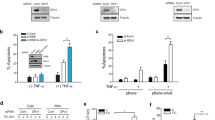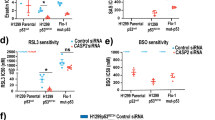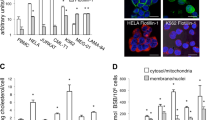Abstract
Protein disulfide isomerase a4 (PDIA4) is implicated in the growth and death of tumor cells; however, its molecular mechanism and therapeutic potential in cancer are unclear. Here, we found that PDIA4 expression was upregulated in a variety of tumor cell lines and human lung adenocarcinoma tissues. Knockdown and overexpression of PDIA4 in tumor cells showed that PDIA4 facilitated cell growth via the reduction of caspases 3 and 7 activity. Consistently, Lewis lung carcinoma cells overexpressing PDIA4 grew faster than did parental cells in tumor-bearing mice, as shown by a reduced survival rate, increased tumor size and metastasis, and decreased cell death and caspases 3 and 7 activity. PDIA4 knockdown resulted in opposite outcomes. Moreover, results obtained in mice with spontaneous hepatoma indicated that PDIA4 deficiency significantly reduced hepatic tumorigenesis and cyst formation and increased mouse survival, tumor death, and caspases 3 and 7 activity. Mechanistic studies illustrated that PDIA4 negatively regulated tumor cell death by inhibiting degradation and activation of procaspases 3 and 7 via their mutual interaction in a CGHC-dependent manner. Finally, we found that 1,2-dihydroxytrideca-5,7,9,11-tetrayne, a PDIA4 inhibitor, reduced tumor development via enhancement of caspase-mediated cell death in TSA tumor-bearing mice. These findings characterize PDIA4 as a negative regulator of cancer cell apoptosis and suggest that PDIA4 is a potential therapeutic target for cancer.
This is a preview of subscription content, access via your institution
Access options
Subscribe to this journal
Receive 50 print issues and online access
$259.00 per year
only $5.18 per issue
Buy this article
- Purchase on Springer Link
- Instant access to full article PDF
Prices may be subject to local taxes which are calculated during checkout








Similar content being viewed by others
References
Galligan JJ, Petersen DR . The human protein disulfide isomerase gene family. Hum Genomics 2012; 6: 6.
Ni M, Lee AS . ER chaperones in mammalian development and human diseases. FEBS Lett 2007; 581: 3641–3651.
Ou W, Silver J . Role of protein disulfide isomerase and other thiol-reactive proteins in HIV-1 envelope protein-mediated fusion. Virology 2006; 350: 406–417.
Naguleswaran A, Yokoi T, Tanaka H, Kawaguchi Y, Shirasaka T, Kamataki T . Neospora caninum protein disulfide isomerase is involved in tachyzoite-host cell interaction. Intl J Parasitol 2005; 35: 1459–1472.
Ellerman DA, Myles DG, Primakoff PA . Role for sperm surface protein disulfide isomerase activity in gamete fusion: evidence for the participation of ERp57. Dev Cell 2006; 10: 831–837.
Manukyan D, von Bruehl ML, Massberg S, Engelmann B . Protein disulfide isomerase as a trigger for tissue factor-dependent fibrin generation. Thromb Res 2008; 122 (Suppl 1): S19–S22.
Garbi N, Tanaka S, Momburg F, Hammerling GJ . Impaired assembly of the major histocompatibility complex class I peptide-loading complex in mice deficient in the oxidoreductase ERp57. Nat Immunol 2006; 7: 93–102.
Andreu CI, Woehlbier U, Torres M, Hetz C . Protein disulfide isomerases in neurodegeneration: from disease mechanisms to biomedical applications. FEBS Lett 2012; 586: 2826–2834.
Li XA, Lee AS . Competitive inhibition of a set of endoplasmic reticulum protein genes (GRP78, GRP94, and ERp72) retards cell growth and lowers viability after ionophore treatment. Mol Cell Biol 1991; 11: 3446–3453.
Severino A, Campioni M, Straino S, Salloum FN, Schmidt N, Herbrand U et al. Identification of protein disulfide isomerase as a cardiomyocyte survival factor in ischemic cardiomyopathy. J Am Coll Cardiol 2007; 50: 1029–1037.
Farquhar R, Honey N, Murant SJ, Bossier P, Schultz L, Montgomery D et al. Protein disulfide isomerase is essential for viability in Saccharomyces cerevisiae. Gene 1991; 108: 81–89.
Norgaard P, Westphal V, Tachibana C, Alsoe L, Holst B, Winther JR . Functional differences in yeast protein disulfide isomerases. J Cell Biol 2001; 152: 553–562.
Hashida T, Kotake Y, Ohta S . Protein disulfide isomerase knockdown-induced cell death is cell-line-dependent and involves apoptosis in MCF-7 cells. J Toxicol Sci 2011; 36: 1–7.
Tufo G, Jones AW, Wang Z, Hamelin J, Tajeddine N, Esposti DD et al. The protein disulfide isomerases PDIA4 and PDIA6 mediate resistance to cisplatin-induced cell death in lung adenocarcinoma. Cell Death Differ 2014; 21: 685–695.
Goplen D, Wang J, Enger PO, Tysnes BB, Terzis AJ, Laerum OD et al. Protein disulfide isomerase expression is related to the invasive properties of malignant glioma. Cancer Res 2006; 66: 9895–9902.
Santana-Codina N, Carretero R, Sanz-Pamplona R, Cabrera T, Guney E, Oliva B et al. A transcriptome-proteome integrated network identifies endoplasmic reticulum thiol oxidoreductase (ERp57) as a hub that mediates bone metastasis. Mol Cell Proteomics 2013; 12: 2111–2125.
Yu SJ, Yoon JH, Yang JI, Cho EJ, Kwak MS, Jang ES et al. Enhancement of hexokinase II inhibitor-induced apoptosis in hepatocellular carcinoma cells via augmenting ER stress and anti-angiogenesis by protein disulfide isomerase inhibition. J Bioenerg Biomembr 2012; 44: 101–115.
Xu S, Butkevich AN, Yamada R, Zhou Y, Debnath B, Duncan R et al. Discovery of an orally active small-molecule irreversible inhibitor of protein disulfide isomerase for ovarian cancer treatment. Proc Natl Acad Sci USA 2012; 109: 16348–16353.
Zhu Y, Xu H, Chen H, Xie J, Shi M, Shen B et al. Proteomic analysis of solid pseudopapillary tumor of the pancreas reveals dysfunction of the endoplasmic reticulum protein processing pathway. Mol Cell Proteomics 2014; 13: 2593–2603.
Pawar H, Kashyap MK, Sahasrabuddhe NA, Renuse S, Harsha HC, Kumar P et al. Quantitative tissue proteomics of esophageal squamous cell carcinoma for novel biomarker discovery. Cancer Biol Ther 2011; 12: 510–522.
Lovat PE, Corazzari M, Armstrong JL, Martin S, Pagliarini V, Hill D et al. Increasing melanoma cell death using inhibitors of protein disulfide isomerases to abrogate survival responses to endoplasmic reticulum stress. Cancer Res 2008; 68: 5363–5369.
Parker R, Phan T, Baumeister P, Roy B, Cheriyath V, Roy AL et al. Identification of TFII-I as the endoplasmic reticulum stress response element binding factor ERSF: its autoregulation by stress and interaction with ATF6. Mol Cell Biol 2001; 21: 3220–3233.
Almeida S, Zhou L, Gao FB . Progranulin, a glycoprotein deficient in frontotemporal dementia, is a novel substrate of several protein disulfide isomerase family proteins. PLoS ONE 2011; 6: e26454.
World Health Organization Cancer Website 2014. http://www.who.int/cancer/en/.
Hanahan D, Weinberg RA . The hallmarks of cancer. Cell 2000; 100: 57–70.
Hanahan D, Weinberg RA . Hallmarks of cancer: the next generation. Cell 2011; 144: 646–674.
Krepela E, Prochazka J, Fiala P, Zatloukal P, Selinger P . Expression of apoptosome pathway-related transcripts in non-small cell lung cancer. J Cancer Res Clin Oncol 2006; 132: 57–68.
Fu Z, Tindall DJ . FOXOs, cancer and regulation of apoptosis. Oncogene 2008; 27: 2312–2319.
Tao GZ, Lehwald N, Jang KY, Baek J, Xu B, Omary MB et al. Wnt/beta-catenin signaling protects mouse liver against oxidative stress-induced apoptosis through the inhibition of forkhead transcription factor FoxO3. J Biol Chem 2013; 288: 17214–17224.
Burgess JK, Hotchkiss KA, Suter C, Dudman NP, Szollosi J, Chesterman CN et al. Physical proximity and functional association of glycoprotein 1balpha and protein-disulfide isomerase on the platelet plasma membrane. J Biol Chem 2000; 275: 9758–9766.
Bratton SB, Salvesen GS . Regulation of the Apaf-1-caspase-9 apoptosome. J Cell Sci 2010; 123: 3209–3214.
Satoh M, Shimada A, Kashiwai A, Saga S, Hosokawa M . Differential cooperative enzymatic activities of protein disulfide isomerase family in protein folding. Cell Stress Chaperones 2005; 10: 211–220.
Carbone DL, Doorn JA, Kiebler Z, Petersen DR . Cysteine modification by lipid peroxidation products inhibits protein disulfide isomerase. Chem Res Toxicol 2005; 18: 1324–1331.
Turano C, Coppari S, Altieri F, Ferraro A . Proteins of the PDI family: unpredicted non-ER locations and functions. J Cell Physiol 2002; 193: 154–163.
Schultz-Norton JR, McDonald WH, Yates JR, Nardulli AM . Protein disulfide isomerase serves as a molecular chaperone to maintain estrogen receptor alpha structure and function. Mol Endocrinol 2006; 20: 1982–1995.
Xiong Y, Manevich Y, Tew KD, Townsend DM . S-Glutathionylation of protein disulfide isomerase regulates estrogen receptor alpha stability and function. Intl J Cell Biol 2012; 2012: 273549.
Kamada S, Kikkawa U, Tsujimoto Y, Hunter T . Nuclear translocation of caspase-3 is dependent on its proteolytic activation and recognition of a substrate-like protein(s). J Biol Chem 2005; 280: 857–860.
Rodriguez-Hernandez A, Brea-Calvo G, Fernandez-Ayala DJ, Cordero M, Navas P, Sanchez-Alcazar JA . Nuclear caspase-3 and caspase-7 activation, and poly(ADP-ribose) polymerase cleavage are early events in camptothecin-induced apoptosis. Apoptosis 2006; 11: 131–139.
Na KS, Park BC, Jang M, Cho S, Lee-Do H, Kang S et al. Protein disulfide isomerase is cleaved by caspase-3 and -7 during apoptosis. Mol Cell 2007; 24: 261–267.
Ciaffi M, Paolacci AR, D'Aloisio E, Tanzarella OA, Porceddu E . Cloning and characterization of wheat PDI (protein disulfide isomerase) homoeologous genes and promoter sequences. Gene 2006; 366: 209–218.
Tiscornia G, Singer O, Verma IM . Production and purification of lentiviral vectors. Nat Protoc 2006; 1: 241–245.
Zahedi P, Stewart J, De Souza R, Piquette-Miller M, Allen C . An injectable depot system for sustained intraperitoneal chemotherapy of ovarian cancer results in favorable drug distribution at the whole body, peritoneal and intratumoral levels. J Control Release 2012; 158: 379–385.
Stauffer JK, Scarzello AJ, Andersen JB, De Kluyver RL, Back TC, Weiss JM et al. Coactivation of AKT and beta-catenin in mice rapidly induces formation of lipogenic liver tumors. Cancer Res 2011; 71: 2718–2727.
Liu XW, Sok DE . Inactivation of protein disulfide isomerase by alkylators including alpha,beta-unsaturated aldehydes at low physiological pHs. Biol Chem 2004; 385: 633–637.
Acknowledgements
We thank the animal facility and the metabolomics facility of the Agricultural Biotechnology Research Center, and the mouse clinics of Academia Sinica for their technical assistance. We thank Drs Jim Stauffer (NCI) and Xin Chen (UCSF) for their SB plasmids, and the National RNAi Core Facility (Academia Sinica) for RNAi reagents. We also thank Ms Miranda Loney for editing the manuscript. This work was supported in part by MOST 104-2320-B-037-033-My2, and MOST 104-2314-B-033-002; NHRI-EX103-10109B1, and NHRI-EX106-10416S1, and KMU-TP104G00, KMU-TP104G01, KMU-TP104A04, KMU-TP105E23, KMU-TP105E23, KMU-TP105E00, and KMU-DT105005.
Author information
Authors and Affiliations
Corresponding author
Ethics declarations
Competing interests
The authors declare no conflict of interest.
Additional information
Supplementary Information accompanies this paper on the Oncogene website
Supplementary information
Rights and permissions
About this article
Cite this article
Kuo, TF., Chen, TY., Jiang, ST. et al. Protein disulfide isomerase a4 acts as a novel regulator of cancer growth through the procaspase pathway. Oncogene 36, 5484–5496 (2017). https://doi.org/10.1038/onc.2017.156
Received:
Revised:
Accepted:
Published:
Issue Date:
DOI: https://doi.org/10.1038/onc.2017.156
This article is cited by
-
Protein disulfide isomerase family member 4 promotes triple-negative breast cancer tumorigenesis and radiotherapy resistance through JNK pathway
Breast Cancer Research (2024)
-
Protein disulfide-isomerase A4 confers glioblastoma angiogenesis promotion capacity and resistance to anti-angiogenic therapy
Journal of Experimental & Clinical Cancer Research (2023)
-
PDIA4 confers resistance to ferroptosis via induction of ATF4/SLC7A11 in renal cell carcinoma
Cell Death & Disease (2023)
-
Identification of molecular subtypes based on chromatin regulator and tumor microenvironment infiltration characterization in papillary renal cell carcinoma
Journal of Cancer Research and Clinical Oncology (2023)
-
Meta-transcriptomic comparison of two sponge holobionts feeding on coral- and macroalgal-dissolved organic matter
BMC Genomics (2022)



